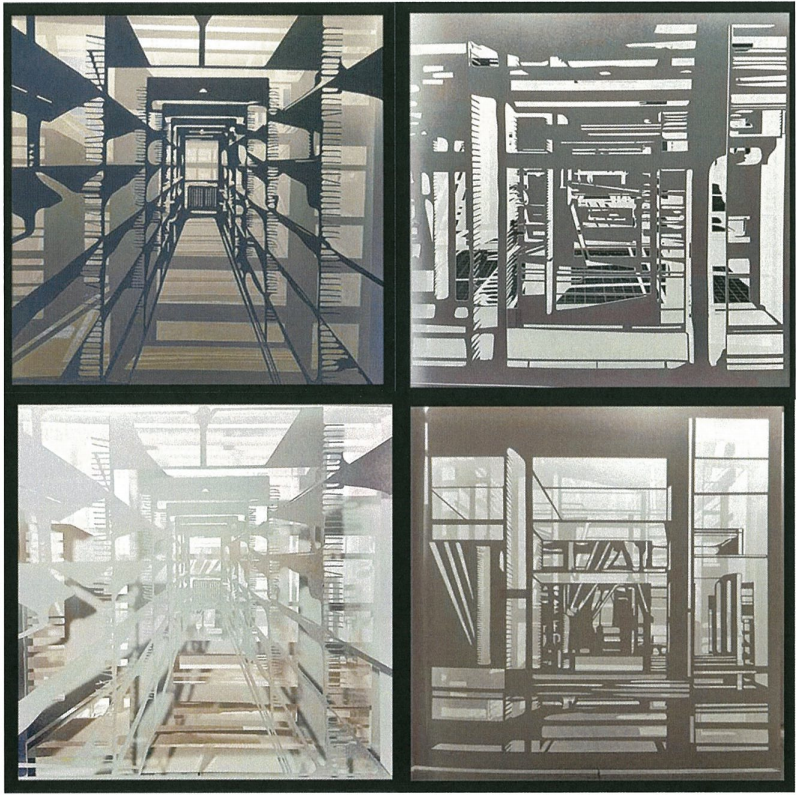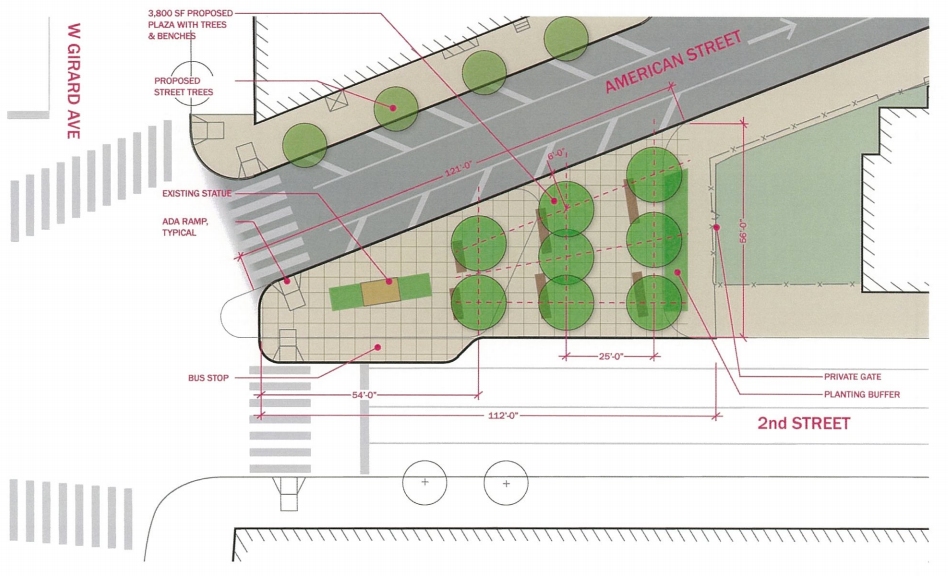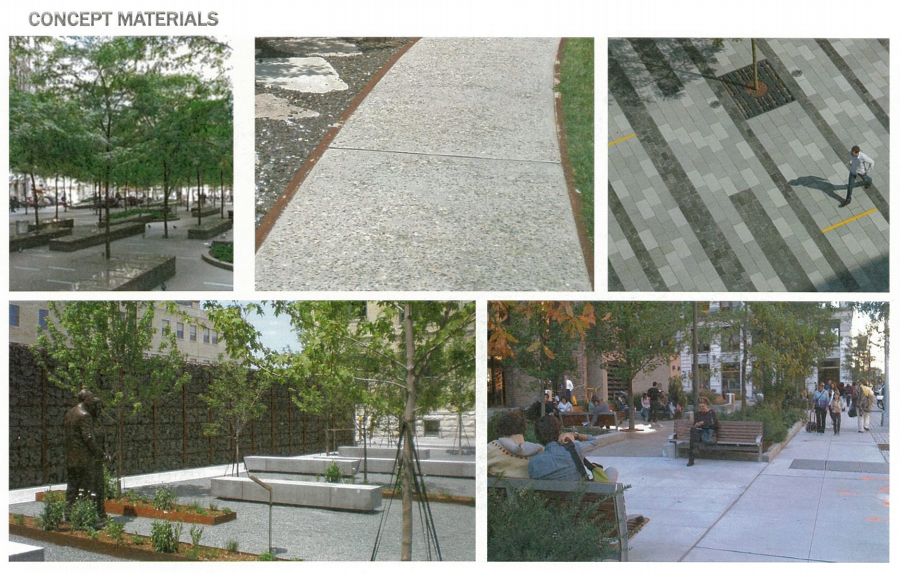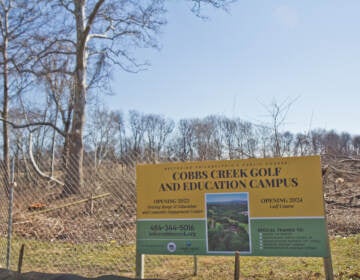Art Commission supports Don Quixote pedestrian plaza, library art, but not PPA lot billboard

The Art Commission’s meeting Wednesday began the year with a bang. The contentious proposal to deaccession stained glass bus shelters on Chestnut Street consumed much of the energy, but the rest of the January session contained several other surprises.
Renovation plans for Smith Playground in Point Breeze got a conceptual approval. The improvements will include the addition of a fitness pod to allow older residents to perform outdoor calisthenics. The area of the park intended for football and baseball, which is often reduced to a dust bowl in the summer months, will be re-done with AstroTurf that the city will be responsible for refreshing.
The commission also conceptually approved an improved pedestrian plaza for the triangular spit of roadway where American and 2nd streets come together at Girard. Currently the intersection is distinguished only by a statute of Don Quixote, which Spain gifted to the city as an exchange between the European nation and “pan-Latino Kensington.” The monument is surrounded tightly by roadways and looks a bit downtrodden (even his helmet is missing).
The new park will get rid of the pass-through that allows automobiles to cross between American, which will now run one-way going north, and 2nd Street. The plaza will include shade trees, seating, and decorative pavement. There will be a bus stop as well, although no shelter structure will be provided.
Commissioners asked about lighting and maintenance, but the details were as yet unclear as the plaza design is still in its early stages. The future of Quixote’s repair is in question too.
“That will be part of our goal to restore it, but we will probably have to raise private funding to do it,” says Margot Berg, Philadelphia’s Public Art Director. “I don’t know if there is city funding to be used for this. As part of that we would replace the helmet.”
Art Commission chairman Alan Greenberger noted that the turnabout seems to be sett paved with stone blocks. He encouraged the city to consider incorporating that stonework into the plaza’s new design, which is evidently one of the options already being considered.
“I would urge you to reuse the Belgian block lest they end up in someone’s garden in Margate or something,” said Greenberger.
The most popular presentation came from Colette Fu, a Philadelphia based artist whose medium is enormous pop-up books. Fu’s work will be incorporated as a Percent for Art project into the grand redesign of the Parkway Central Branch of the Free Library of Philadelphia. Only 35 percent of the building is currently open to public use, with the rest devoted to storage and staff.
The northern sections of the building, which currently contain vast stacks for the library’s collection, will be converted into a public space. Two floors and tens of thousands of square feet will be opened to the public, with the books being moved off-site to a storage facility at the University of Pennsylvania’s Pennovation Center. New additions include a teen library and a massive art installation making use of some of the shelving that currently accommodates the stacks.
Although much of the six levels of shelving will be removed, some will remain along the west and east sides of the room to be used as both furniture and artwork. 112 applicants were considered for the art component and Fu’s design proved most popular.
Fu’s installations are based on tunnel books, which are box-like dioramas with a viewing hole that give a multi-dimensional perspective. A collage of imagery and text will be presented in a swirling, multi-layered format. The visage within the installation is meant to inspire a memory of the stacks, and of books more generally.
The stack-like decorations will be adorned with text from Philadelphia poets and authors and details of the historic means of finding books—like the card catalogue—and historic figures of the library system in Philly. Lights will be mounted on top of the boxes to illuminate the scene within. There will be eight of these installations four on the east side and four on the west, inserted into the remaining stacks.
The Art Commissioners were uniformly enthusiastic about the project, and gave Fu’s presentation an ovation at its conclusion.
“I commend the library for commemorating the very tactile and sensorial experience of reading and books,” said Philadelphia University’s Natalie Nixon, “in spite of the need to just keep up with the reality and moving the collection to another storage space. I think it’s a really great way to denote the experience of reading and gathering and where it takes you.”
The rest of the stacks will be decorated as well and the contents shielded behind glass, although it is unclear what will be held in them. (The library doesn’t like the idea of having unattainable tomes on display, so books may not be part of the larger installation.)
The spell of comity was then broken by the question of the Chestnut Street bus stations, which prompted Greenberger to voice a concern about the broader question of contentious projects—often hinging upon advertising—that keep roiling the Art Commission. He emphasized, as he had during the consideration of advertisements on municipal buildings, that such presentations are made without context from the city and are not placed within a broader strategic framework for the commission.
“I suggest we have a separate special meeting to discuss this, because the 21st century is upon us,” said Greenberger, in reference to the explosion of digital signage. “There are things being considered now that people, certainly the City, knows will require Art Commission approval. While we need to meet in public we also have many times in the past met as smaller subcommittees to discuss what might or might not happen at commission.”
That brought the commission to a proposal from the Philadelphia Parking Authority to install a billboard at its lot on 1339 South 12th Street, at Wharton Street in South Philadelphia. There used to be an illuminated and bisected billboard there, removed a year ago, so L&I assented to the new billboard without a variance.
The proposed billboard is 74 square feet, about 20 square-feet larger than the previous sign, but would not be illuminated at night. It would be operated by the Bayberry Media Company.
The commissioners asked if the Parking Authority had met with the community in regards to the sign proposal, which they have not. The lawyer for the PPA, Hercules Grigos, said that because they are proposing a new billboard where an old one existed they didn’t need a variance. But because the land is city-owned they needed the commission’s approval.
“Have you confirmed in the zoning files that there is a permit that allows this,” Greenberger asked. Grigos and the reps from PPA and Bayberry were unsure, but he later told Greenberger the proposal was legal because there previously had been a sign there. The chairman seemed unconvinced.
“I would like to understand better the prior legality of the sign that was there,” said Greenberger. “That’s got to be clear because I don’t want this commission approving something that turns out not to have the right legal basis. If we’ve been operating for decades with an illegal sign that means something.”
Mary Tracy of Scenic Philadelphia registered her dissent too.* The zoning code doesn’t allow billboards within 660 feet of a park or 500 feet of residential dwellings. This parking lot is across the street from a park in the midst of a densely packed rowhouse neighborhood, so how was this allowed?
Grigos informed her that the parking lot is city owned, and the city exempted such properties from non-accessory advertising laws that would otherwise apply. He said they had checked with the Law Department and the Department of Public Property on the legality.
But in the end the commissioners asked them to withdraw the proposal, and come back if they wished. It was decided that the rendering they provided showed the sign as smaller than the commission believed it would actually be. Furthermore, images of the backside of the sign, and what it would mean for neighbors in the sight line, were not provided. And the commission still felt the legality needed to be vetted more thoroughly.
This wouldn’t be a one-shot deal. The package that the PPA submitted to the Art Commission included a letter to L&I from the Commissioner of Public Property authorizing permits for five PPA sites. Four of them, including the one before the Art Commission Wednesday, are in South Philadelphia. The fifth is for a lot behind the Central Branch of the Library. Grigos seemed to imply, at the conclusion of the meeting, that the one on Wharton and 12th would be a test case before the others are acted upon.
“An open air parking lot, I understand from my real estate perspective, is nor the highest or best use, and outdoor advertising is not the highest and best use,” said Grigos. “But they are necessary things. How can we improve those things to make them as palatable as possible? We hope that this process can generate something where we get good info to create something…revenue for the city and the parking authority is important so how do we make it palatable?”
*Mary Tracy sits on PlanPhilly’s Community Advisory Board.
WHYY is your source for fact-based, in-depth journalism and information. As a nonprofit organization, we rely on financial support from readers like you. Please give today.







